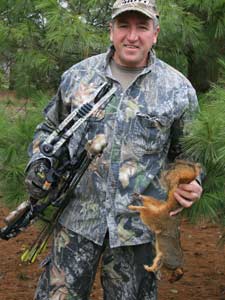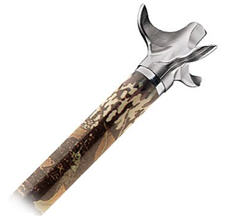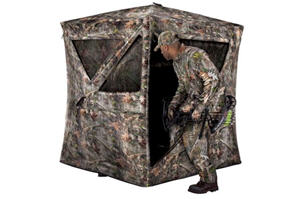
Two or three weeks of archery deer season is the only time some bowhunters wrap their fingers around a bow's grip. Many bowhunters invest only a few weeks of random practice before opening day, and then allot a few weekends to hunt after the opener. After those few weeks are over, they hang up their bows and move on to other pursuits until the next archery deer season rolls around. It's a shame, too, because those hunters are missing out on one of archery's greatest challenges and thrills — arrowing small game.
 There are many reasons to take on rabbits, squirrels, groundhogs and other small game species with a hunting bow and arrow. The seasons are long (some year-round), the bag limits are liberal, and the places to hunt are more than you can possibly ever cover in a lifetime. Tired of crowds on public lands? Visit during any of the small-game-only seasons; you'll see your hunting haunts in a different light.
There are many reasons to take on rabbits, squirrels, groundhogs and other small game species with a hunting bow and arrow. The seasons are long (some year-round), the bag limits are liberal, and the places to hunt are more than you can possibly ever cover in a lifetime. Tired of crowds on public lands? Visit during any of the small-game-only seasons; you'll see your hunting haunts in a different light.
Need something exciting to do with your bow that will make arrowing a deer a not-so-overwhelming task? Try arrowing a squirrel. Looking for a bowhunt when a fresh snowfall covers fields and forests? Go outdoors and follow the rabbit tracks.
You CAN hunt the other 10 months of the year with a bow, and the more times you draw and release an arrow, the better you'll become at bowhunting — period. One proven way to improve as a bowhunter is to start hunting small game. What's that you're thinking? Those mini-critters are too hard to hit? Look at the problem in reverse; they cause you to pick a smaller spot, concentrate with greater attention, and then hold steadier upon release.
Tip: Delicious Wild Game Stew Recipes
Ready, Set, Hunt Small Game

Small game hunts offer big thrills. Ok, I'll be the first to admit you'll not grow fat eating the squirrels, rabbits and other small critters you'll take en masse with a bow. Those small critters are somewhat difficult to hunt, but the thrill is in the chase. In fact, arrowing a squirrel can be as satisfying as taking a big doe — often more satisfying.
Hunting Squirrel
Squirrels lead the small-game group of great bow targets. Squirrels are plentiful, they often come down to the ground, and the seasons are long. Many states have seasons open until late February — or later. I hunt squirrels with practice arrows and small game heads. The pursuit becomes a game of sneaking among thick tree trunks and seeking squirrels perched atop logs and eating acorns or hickory nuts.
As a rule of thumb, standard sight pins will completely cover a squirrel at 20 yards, so most shots will be close range. Upon release, if you miss, the squirrel often jumps up, barks a while, and returns to feeding. I suspect that squirrels think a passing arrow is a fly-by hawk. I don't shoot at squirrels up in trees, but do wait until they come down to ground. You'll find squirrels out of their dens on most cold winter days.

If you spot a farm with standing corn, you might also find it easy to obtain permission to hunt squirrels there. The rodents love to raid cornfields, and these sites are their top targets when mast is covered with snow. Gnawed ears of corn are easy to spot, and you can often sneak among
the stalks to find an unsuspecting bushytail. Squirrels can also be located with mouth blown squirrel calls that are widely available for sale. Take note that squirrels have keen eyesight, so consider wearing a head net and camouflaged hunting gloves on your hunting quest.
Tip: How to skin squirrels: Step by Step Picture Guide
Hunting Rabbit

A second-best small-game target species is rabbits. Though cyclical in population levels, rabbits are generally plentiful and widespread. Seek them along the edges of overgrown fields, and stop to study any blow-down tree tops, brair patches, and honeysuckle thickets. When a rabbit sees you, it will normally freeze in place. If there's snow on the ground, the brown blobs are easy to spot. Without snow, look for a very shiny black eye of the rabbit, or possibly pink ears.
Small game points like the G5 Outdoors Small Gamed Fixed-Blade Broadhead or blunts work best to subdue a rabbit with a bow and arrow. In most cases you'll have to kneel down to shoot up under brush and connect with the rabbit, so very colorful arrow fletching or arrow vanes and feathers helps in the arrow recovery process. Briar chaps or brush pants can help you wade into a briar thicket to retrieve your rabbit.
Hunting Raccoons

One other species that begs bowhunters to come out during winter is raccoons. Cornfields offer the best opportunities, and a recently cut cornfield will draw the masked bandits in from near and far. Some states classify these bandits as small game. Check your state raccoon hunting regulations, however, because some states only permit hunting with dogs.
Other states just have established hunting dates and raccoons can be legally hunted whenever you see them.
Dawn and dusk are the best times to seek-and-sneak raccoons. Use a binocular to scan a cornfield as you hide in nearby brush. Once you spot a raccoon that stops to eat, start your move. Raccoons can best be anchored with a sharp broadhead backed by a small game stopper on the arrow shaft.
Hunting Groundhogs & Marmots - Hole Digger Havens

Generally, anyone with land hates groundhogs, marmots and smaller hole digging species like prairie dogs and ground squirrels.
You know these small pests are creating big problems when you spot the mounds of dirt. For the larger groundhogs and marmots, your routes to success are to spot-and-stalk, or to locate an active den entrance and wait patiently uphill from that site.

These pest rodents are also fond of coming out to sun on warm afternoons and can also be spotted lying on rock or on top of logs. Groundhogs and marmots, however, will be underground during the winter. Groundhogs can also be hunted around small family gardens and apple orchards. These rodents can climb apple trees to steal fruit, and they love to raid gardens and eat green beans. Groundhogs reside on both slopes of the Appalachian Mountains from Georgia to Maine, and their look-alike cousins, the marmots, live in and along the Rockies.
Hunting Ground Squirrel & Prairie Dogs

Ground squirrels and prairie dogs also are western pests that offer arrow flinging opportunities. Ground squirrels are often easy to approach, but are definitely smaller targets. Your bow's 10 yard pin will often cover one of these small pests. Prairie dogs are plentiful, but can be difficult to approach. Try using a hunting ground blind and sitting-in-wait along the edge of a sprawling dog town.
Pack plenty of arrows because once the prairie dogs come up, you can release many arrows before they become weary. Then simply gather your arrows, and move the blind to another spot along the town. Some states, like Montana and Wyoming, permit nonresidents to hunt these plentiful pests without a hunting license. Like groundhogs and marmots, these rodents spend much of the winter underground in dens.
Bows and arrows are good for more than deer hunting. If you hang your bow up for the 10 months that some hunters call the off-season, you're missing out on some of the most challenging and satisfying hunting that an archery enthusiast can experience.
- 36301 views

